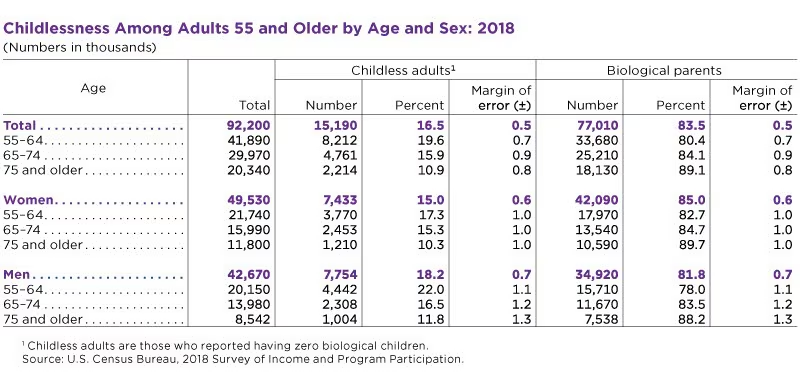The Economics Of Being A Childless Cat Lady Or Gentleman

With elections approaching, let the political mudslinging and insults begin! This time, its regarding being childless and loving cats.
Republican VP nominee JD Vance said this during an interview with Tucker Carlson:
“It doesn’t make any sense that we turned our country over to people who don’t really have a direct stake in it. All I’m saying is that we’re effectively run in this country, via the Democrats and corporate oligarchs, by a bunch of childless cat ladies who are miserable with their own lives and the choices they’ve made. And so they want to make the rest of the country miserable too. It’s just a basic fact. You look at Kamala Harris, Pete Buttigieg, AOC – the entire future of the Democrats is controlled by people without children.”
Here’s the video of him mentioning childless cat ladies and more.
Jennifer Aniston, who rarely makes political statements, responds to @JDVance’s comments about “childless cat ladies who are miserable at their own lives.”
“I truly can’t believe this is coming from a potential VP of The United States. All I can say is…Mr. Vance, I pray that… pic.twitter.com/oNOJw3xtY0
— Yashar Ali 🐘 (@yashar) July 25, 2024
Ouch! If I were a childless cat lady, I’d be furious at his remarks. It’s annoying to hear people debase those who don’t have what they have. JD Vance, of course, has three children. It’s like rich people with wealthy parents saying, “Just work harder! Stop being so lazy!”
To them, you should rightly feel justified in telling them to “F off!“
In light of JD Vance’s comments about childless people, I thought I’d go through the economic benefits of being childless. Given Donald Trump is favored to win, JD Vance is likely also to become America’s next Vice President. Although, the race has gotten much closer after Biden dropped out and JD Vance became Trump’s running mate.
Reasons Why Adults Don’t Want To Have Children
Before we begin, I’d like to highlight a recent Pew Research poll that shows the reasons why adults are not having children. The biggest reason adults ages 18 to 49 are unlikely to have children is simply because they DON’T/DIDN’T want to, accounting for 57% of the respondents.

Given that we are in the realm of personal finance, we often focus on the high cost of having children. However, that reason ranks only third at 36%. While children are undoubtedly expensive, respondents are indicating that their decision not to have children goes beyond financial considerations.
If you don’t want to do something, especially when it comes to having children, you shouldn’t feel obligated to do it. Raising children demands significant time and resources for over 18 years.
Meanwhile, “haven’t found the right partner” came in at 24% and “infertility and other medical reasons” came in at 13% for those adults ages 18 to 49. Hence, I think it’s cruel for JD Vance to make fun of any woman who doesn’t have children.
The Percentage Of Women Who Don’t Have Children
It’s also good to know that according to recent data from the U.S. Census Bureau:
- For women in their childbearing years (15-44), approximately 44-48% don’t have children.
- For women at the end of their childbearing years (40-44), about 15-20% are childless.
- The percentage of childless women has been steadily increasing over the past few decades.
So you see, a large percentage of women don’t have children. So JD Vance is playing with fire when he attacks women for being childless. It doesn’t seem like a smart move.


JD Vance’s statement caught my attention because my wife and I were childless cat owners for five months. In 2016, after experiencing a miscarriage, we came to terms that we might not become parents and decided to adopt a cat instead.
We chose to live a simple, low-cost life with our furry friend. However, there was one major issue: I was highly allergic to cats! To address this, we went to a special breeder in Marin County who had hypoallergenic Siberian cats.
Although we loved the cat, after three months, I began experiencing breathing issues. Having had severe asthma as a child and being hospitalized twice, the cat’s presence triggered my breathing difficulties again. Consequently, we returned the cat after five months and received half our money back.

Had we remained a childless couple with a cat, we would be financially better off today. We likely would have enjoyed our lives immensely, as we both retired early and had six-figures in passive income. Therefore, I thought it would be interesting to review the economics of being childless with a cat.
1) No Need for a Larger House ($20,000 – $50,000 in Annual Savings)
With just yourself and perhaps a partner, you can comfortably live in a one-bedroom apartment. There’s no need to have a three-bedroom house to accommodate a nursery and an office.
In San Francisco, a nice one-bedroom apartment in a great location costs about $3,600 a month, while a three-bedroom single-family home or apartment in a luxury high-rise costs $6,000 – $7,000 a month.
2) No Need to Pay for Expensive Private Tuition ($2,000 – $60,000 in Annual Savings)
Sending a child to private school can cost anywhere from $12,000 to $60,000 a year, depending on location and grade. With a cat, there’s no need for private school tuition!
Even with public school, there are still annual donations, books, transportation, and other fees involved.
3) No Need to Buy a Large and Safe Car ($30,000+ in Savings
A $21,000 new Honda Fit hatchback is sufficient for a car. In fact, an $8,000 used Fit, Corolla, Sentra, Yaris, or any other economical car will do just fine for a cat. The smallest car to a cat is like a stretch limousine to a human.
In December 2016, we spent $61,000 after tax on a 2015 Range Rover Sport because we didn’t feel safe driving a baby around in a Honda Fit with thin doors. If we had invested that $61,000 in the stock market back then, it would be worth over $130,000 today.
4) No Need to Save for College Tuition ($400,000 – $1 Million in Savings)
One of our parental obligations is to provide the best education for our children, which requires saving and investing for their college education. By being a childless cat owner, you can avoid saving between $400,000 – $1 million for your child’s college education. All that money saved can be used to fund your retirement, go on fabulous adventures, and buy the best cat food money can buy!
Each child requires you to save enough to achieve Coast FIRE for their college tuition, in addition to your regular retirement savings.
5) Cheaper Transportation Costs for a Cat ($50 – $700 per Trip)
Most airlines allow small pets in carriers to be placed under the seat in front of you, with fees typically ranging from $95 to $125 each way for domestic flights. This is 50% – 80% cheaper than the cost of an adult ticket and children ages 2 and older.
If you take a bus or train, the cost to bring a cat is even cheaper. Greyhound charges $30 and Amtrak charges $26 per pet. Pretty good value for your cat companion!
6) No Need for Therapy or Coaching ($200 – $2,000 a month)
We humans are complicated beings, constantly struggling with purpose and meaning. Take, for instance, my post about my parental existential crisis. As a result, we can often get down on ourselves, which may require professional help.
With a cat, there’s no need to send it to a therapist. You don’t need to pay for expensive after-school lessons to give your cat greater joy in life. A cat is happy just being fed, played with, and left alone. And you can get catnip at Walmart for just $2, what a bargain.
7) No Need for Shoes Or Clothes, Like Ever ($500 – $2,000 a year)
The great thing about cats is that they can walk around naked forever. They have self-renewing fur that keeps them covered indefinitely. In contrast, your children will outgrow their shoes, shirts, and pants every 6 months.
We are shocked at how many holes our 7.5-year-old son gets in his pants and shoes. It’s almost as if there’s a defect in his clothing.
The Cost Of Caring For One Cat
The cost of caring for a cat can vary depending on factors like the cat’s age, health, and your lifestyle choices. However, here are some general estimates based on average costs in the United States.
Monthly cat expenses:
- Food: $20 – $40
- Litter: $15 – $25
- Toys and treats: $10 – $20
- Pet insurance (optional): $15 – $30
Monthly total: $60 – $115
Yearly cat expenses:
- Monthly expenses x 12: $720 – $1,380
- Annual veterinary check-up: $50 – $200
- Vaccinations: $50 – $100
- Flea/tick/heartworm prevention: $100 – $200
- Unexpected medical expenses (budget for): $200 – $500
Yearly total: $1,120 – $2,380
One-time initial costs (first year):
- Adoption fees: $50 – $200
- Spaying/neutering: $200 – $500
- Initial vaccinations and medical exam: $100 – $200
- Supplies (litter box, carrier, scratching post, etc.): $100 – $200
Total one-time initial costs: $450 – $1,100
These figures are estimates and can vary widely based on location, specific products chosen, and individual cat needs. Some cats may have higher medical expenses, while others may need less frequent vet visits. Additionally, costs can increase significantly if your cat develops a chronic health condition or experiences an emergency.
So Much Cheaper Raising a Cat Than a Child
It costs up to $2,500 a year to raise a cat in today’s dollars. According to the U.S. Department of Agriculture’s (USDA) most recent report from 2017, the average annual cost to raise a child is $13,000 to $15,000 per year, with a total cost from birth to age 17 of $233,610 (in 2015 dollars).
Using a 3% annual inflation rate, the cost to raise a child rises to about $305,000 from birth to age 17 today. The average annual cost to raise a child increases to $17,000 – $19,600 today.
In other words, it costs $14,500 – $17,100 a year less to raise a cat. What a bargain! And the bargain is even greater if you plan to send your kid to private school and have multiple kids.
So Much Less Stressful Raising a Cat Too
Not only is raising a cat much cheaper than raising a child, but cats also don’t talk back or cause you a lot of grief. They might get grouchy and swipe at you with their claws from time to time, but for the most part, cats are low maintenance, which is one of the reasons I like them.
Cats don’t give you mini-heart attacks by running into the street or walking off ledges as toddlers do. After all, there’s a reason why cats are said to have nine lives! You don’t have to worry about them hurting themselves. They can fall from a one-story building and land just fine.
You don’t have to worry about your cat getting pregnant or getting addicted to drugs and alcohol either. Finally, you don’t have to worry about having a lonely and depressed cat because they have you and all the food you feed it!
Embrace Your Childless, Pet-Loving Status
JD Vance says Americans without children should “face the consequences and the reality” and not get “nearly the same voice” in democracy
Vance: “Let’s give votes to all children in this country, but let’s give control over those votes to the parents of those children.” pic.twitter.com/uYS6NcGkKn
— Pat Rynard (@patrynard) July 24, 2024
If you’re a childless cat lady or gentleman, enjoy the good times! You get a vote in our country just like any other human on this planet. You have skin in the game, especially if you are part of the ~50% who pay income taxes. If you’re an illegal immigrant who doesn’t pay taxes, you can’t argue you deserve a vote.
Don’t let parents like JD Vance make you feel inferior just because you don’t have children and like pets. The freedom you have is priceless. Enjoy it!
Famous Childless Cat Ladies
- Florence Nightingale – The pioneering nurse was known to have up to 60 cats throughout her lifetime.
- Harriet Hosmer – A 19th-century American sculptor who never married and was devoted to her cats.
- Patricia Highsmith – The acclaimed crime novelist lived alone with her cats and snails.
- Beryl Reid – British actress who left most of her estate to her cats when she died.
- Louisa May Alcott – The “Little Women” author never married or had children, but was fond of cats.
- Emily Brontë – The “Wuthering Heights” author was known to be very attached to her cats.
- Dorothy Parker – The writer and critic was known for her wit and her love of cats.
- Greta Garbo – The reclusive actress lived alone in later life and was often seen walking her cats.
- Taylor Swift – The musician who could easily sway an election if she spoke up
- Oprah – Talk show host and multi-billionaire who never officially married.
- Jennifer Aniston – An actress who made us laugh in Friends and some Adam Sandler movies on Netflix recently
All of these women led rich, fulfilling lives and made significant contributions to their fields, regardless of their marital status or choice to have children. Their love for cats was just one aspect of their complex personalities. Let’s turn any negative connotations of being a childless cat lady to a positive!
Famous Cat Gentlemen Who Didn’t Have Children
Here’s a list of famous “cat gentlemen” who were known to have never had children:
- Nikola Tesla – The brilliant inventor and engineer was devoted to his work and his cats.
- Edward Gorey – The American writer and artist was known for his eccentric, macabre works and his love of cats. He left his estate to animal welfare charities.
- Andy Warhol – The iconic pop artist had several cats throughout his life, including 25 cats all named Sam.
- Maurice Ravel – The French composer, known for “Bolero,” was a lifelong bachelor with no children. He was fond of cats and often wrote music with his cat sitting on his piano.
- Glenn Gould – The Canadian classical pianist was known for his eccentricities and his love of animals, particularly cats.
- Samuel Johnson – The English writer and lexicographer, famous for compiling the first English dictionary, was childless and kept a cat named Hodge.
- Sir Isaac Newton – Invented calculus and did tremendous work on gravitational forces. He was known to be devoted to his work and his cats.
These men were all accomplished in their respective fields and known for their affection towards cats, while also never having children of their own. Let’s make the term “cat gentlemen” a positive too!
Favorite Cat Movie Scene
Finally, let me leave with you with one of my favorite cat movie scenes of all time from Meet The Parents. How can you not want a cat, childless or not, after watching this?
Readers, are you a childless cat lady or gentleman? How do you feel about what JD Vance remarked? Do you feel you have a stake in our country if you don’t have kids? What are the main reasons why you are childless?
To expedite your journey to financial freedom, join over 60,000 others and subscribe to the free Financial Samurai newsletter. Financial Samurai is among the largest independently-owned personal finance websites, established in 2009.




